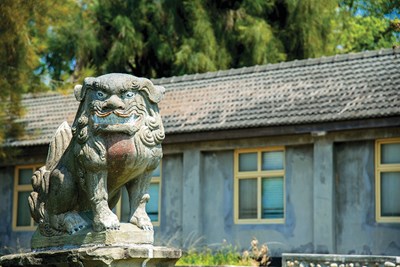
A coastal journey rich in nature and humanityVisiting historic Qingshui Old Street
Words by Wu Chang-kun
Translated by Anna Yang
Photos by Reflection Photography
Photos provided by CingshueiLive
Qingshui is a significant, historic area along Taichung's coastline whose past dates back 4,000 years to the Niumatou Culture. About three centuries ago, Han Chinese settlers arrived and developed Qingshui into a major residential and religious center. When visiting this district today, don't miss a stop at Aofeng Sports Park, filled with natural and cultural ambiance, as well as Qingshui Old Street with its food delicacies.
With views toward the Dadu Mountain ridgeline to the east and the western coast, Qingshui overflows with beautiful scenes. It has also long been an attractive place to live, thanks to abundant water resources found to its north, where Dajia River and natural springs in the foothills of Dadu Mountain are located.
According to anthropologists, traces of human settlement dating back to about 4,500 years ago have been found at an excavated Niumatou era site. At that time, the Papora Taiwanese plains aborigine tribe named this location Gomach. In 1920, when a spring was discovered at the foot of Aofeng Mountain, the local name was changed to Qingshui, or "clear water". Beginning in 1733, Han Chinese settlers developed the surrounding area and, from 1764, Qingshui's main access road boosted economic growth and made this a religious gathering point.
Local guide Wu Chang-kun provides further historical understanding with the following tour of Qingshui's old streets.
Origins of Qingshui: Beizhiko (埤仔口) spring The modern-day Qingshui Water Plant, built in 1929, was once known as "Beizhiko" and originally a spot where residents washed their clothing in spring waters. The largest area temple is Tzuyunyen, worshiping the goddess Guanyin and an old tomb from the Qing dynasty's Qianlong reign period is found behind it. Tiaoyuangong's King Sanshang Temple has been around for 200 years was possibly established by Hakka immigrants. Kaichifude Temple was the first local earth god temple and attracted merchant worshipers with the wealthy symbols on its roof.
Before the Qingshui military route (present-day ZhongShan Road) was developed, Daje Road was Qingshui's most flourishing thoroughfare and home to several rich families and their businesses (Tsai Yuan-shun, Tsai Chuan-cheng's shop and Wangki oil products). Today, it is still lined with restaurants, a shopping complex, police station, and bus stations. Following the development of water-irrigation techniques by the Yang Tong-hsing family in 1780, many area farmers' fields were irrigated from the nearby river. Dajia River waters were also conveyed to Beizhiko and diverted to various locations.
The local holy mountain: Aofeng Mountain
Referred to locals as Qingshui Park, Aofeng Sports Park is filled with natural scenery and greenery that includes acacia and Chinaberry trees and guinea grass, with changing leaf colors in spring and winter adding to the beauty on Aofeng Mountain.
Stone flood-prevention walls in Aofeng Sports Park create a unique spectacle while the Niumatou Cultural Park exhibits historic remains, including a temple and military facilities. Managed by the Cultural Heritage Department of Taichung CIty, the recently developed Papora Cultural Center offers coffee, meals, DIY creative and culture products, and exploration and experience opportunities.
As you walk along WuCuo Road, grass areas perfect for picnicking can be seen. If you take Aofeng Jade Bridge over Ciaotoliao Creek and continue on the Hutou hiking trails, you'll quickly come to the popular Aofeng Observation Point and the best panoramic lookout point in Qingshui.
Hengshan Tunnel System, also known as the Qingshui Ghost Cave, was an adventurous place explored with torches by children in the past. As their military facilities in Taiwan came under Allied attack near the end of World War II, the Japanese constructed this rock-walled complex that included rooms, sentry boxes, sniper positions and weapons storage areas.
Qingshui disaster memorial monument and old streets
A memorial monument was placed on a hillside by Qingshui Temple in memory of a devastating earthquake disaster on April 21, 1935. The following year, the Japanese colonial government developed a rectangular street layout (with vertical roads and horizontal streets), laying the foundation for Qingshui's popular nostalgic street culture and interesting sights.
The eye-catching WenChang Street, lined with Japanese-style buildings (and once named Shibakantze( 十八坎仔) was built in 1937 and famed for its popular 18 shops running along the coastline. The 300-year-old Shoutien Temple is the oldest Mazu Temple in Qingshui while Nanhaiyen Guanyintze temple, also known as Sheliaoma (社寮媽), records interactions between Taiwanese plains aborigines and Han Chinese. Donggong Temple and Wang's Family Temple have also recorded the development of the old street from the Qing Dynasty. South of the old street, 80-year-old bamboo in the Li Family's mansion complex and Qing Dynasty guard booth can also be observed.
Historic landmarks: Qingshui Elementary and Japanese-style dormitory
Qingshui Elementary School was Qingshui's first elementary institution when established on April 1, 1935. The tall U-shaped school building has red brick walls and wooden windows and door frames, showcased by a surrounding bright, spacious campus. The monument beneath a big banyan tree was transported from Taipei's Chishan Mountain, which the Japanese considered a sacred place to receive education. The tree itself was planted by former principal Shutoku Kawamura in 1935 and has witnessed Qingshui Elementary School's development over the decades.
The six wooden dormitory buildings on the campus's north side contain 11 rooms and were built in 1934 with a mix of Japanese and western-style housing. This school's combination of cultural spaces and historic buildings set a new precedent in Taiwan and have made it a landmark preserved for educational purposes.
Mouthwatering old street delicacies and souvenirs
Visitors to Qingshui frequently ask, "Which glutinous rice cake shop is the best one?" Two guiding principles are recommended: First, look for a shop using local, seasonal ingredients; second, look for one that sells limited quantities for a limited time. Thus, if a shop opens early and sells out around noontime, it is definitely a top local dining choice.
Wangta Glutinous Cake has been in business for over half a century and other glutinous cake shops include Ah-Tsai Mi Gao, Zheng-Pai Mi Gao and over 30 other businesses with distinctive flavors and sauces. Besides glutinous rice, another popular treat is the famous fried patty with crispy dough skin and sweet stuffing. Taiwanese "baitou tsai" and "Ah-wen ba wan" meatball shops also quickly sell out. Other flavorful delicacies can be found at places like Yang's Salty Meatballs, Liao's Peanut Glutinous Rice Balls, Ah-po Tapioca, Mitaimu Fu, King Goose, and Haociaoli Meat Buns, making Qingshui a lively dining destination for hungry locals and visitors.
Qingshui's pastry shops also have a long history and every shop offers its own proprietary baked goods and unique characteristics. For instance, Bachengsiang Pastry Shop sells traditional items like the Red Bean Mochi Pastry, while other great, nostalgic flavors can be found in Shililiang's Almond Thin Cookies and Yimei Shop's Taro Sun Cakes, which all make excellent souvenirs for tourists. It is also recommended that visitors go to cultural and creative business "CingshueiLive" to make purchases from an abundance of souvenirs and items such as local maps and creative products, plus natural, low-sugar handmade cookies and noodles.
Tour guide:
Wu Chang-kun
Wu Chang-kun was born in Qingshui and graduated with a degree in Veterinarian Medicine from National Pingtung University of Science and Technology. He has promoted numerous cultural and creative events and community development over the past 30 years and is now chairman of Niumatou Cultural Association and an executive at CingshueiLive and Papora Cultural Center. He has founded associations for Taichung classical music, Niumatou Culture, Qingshui culture and products, outstanding Taichung arts, and the promotion of the Gaomei Wetland Wildlife Refuge, and has also participated in community development events at several community colleges.

 Facebook
Facebook
 Twitter
Twitter
 LINE
LINE